The weather forecast is important when RVing. Camping in bad weather can be dangerous for you and your RV and it can happen in the blink of an eye. Knowing what to expect ups your chances of being prepared and safe while on the road.
The National Weather Service provides information about current and future conditions with forecasts in most areas of the United States at least 4 times per day. Knowing this information beforehand will help you save time and money by making appropriate decisions before setting out on a trip.
Even if you’re not traveling that particular day, you’ll still be ahead of the game if you keep track of the forecast. Since I’m full-time, I have traveled in all conditions, but I only travel in adverse conditions when I have no other choice.
How To Get The Weather Forecast While Traveling
When I’m planning far ahead I like to look up the weather trends for any particular area online. Say I plan to be in Moab, Utah in October. I’ll search Moab, Utah weather in October. This will give me the typical conditions so I can decide if that’s a good time to go there or if I should go earlier or later.

For day-to-day forecasts, I rely on phone apps. I have an Android device and am currently using The Weather Channel Weather Widget. I set it up so I have allowed it to access my location when the app is in use so it changes locations along with me. That gives me access to local weather forecasts wherever I go.
Many people use NOAA Weather Radios to keep informed of severe weather. Since weather alerts are broadcast via radio, it will wake you up if an area is experiencing weather-related emergencies. Some weather radios run on batteries and some have a hand crank so they can be used without electricity or cell phone coverage.
What To Look For In The Weather Forecast
Camping in High Winds
I can’t begin to tell you how many RV awnings I have seen destroyed by wind and rain. All it takes is one good gust of wind or quick downpour and your awning is toast. I’ve seen them blown over the top of an RV, collapsed by water weight, completely ripped off the side of a rig, and even blown across the campground.
My best advice to you is never leave your awning deployed when you leave your RV or when you go to bed at night. This applies even when the weather is good. That’s advice that will save you between $2,000 and $5,000. Even if you use awning tie downs, it’s just not worth the risk. Camping in bad weather happens suddenly sometimes.
Driving in strong winds is dangerous. If the wind is blowing hard enough to make my trailer move to the point I can feel it, I get off the road. There’s no place I have to be so why take the chance?
I’ve seen photos of winds in the great planes that literally blow semi-trucks onto their sides.
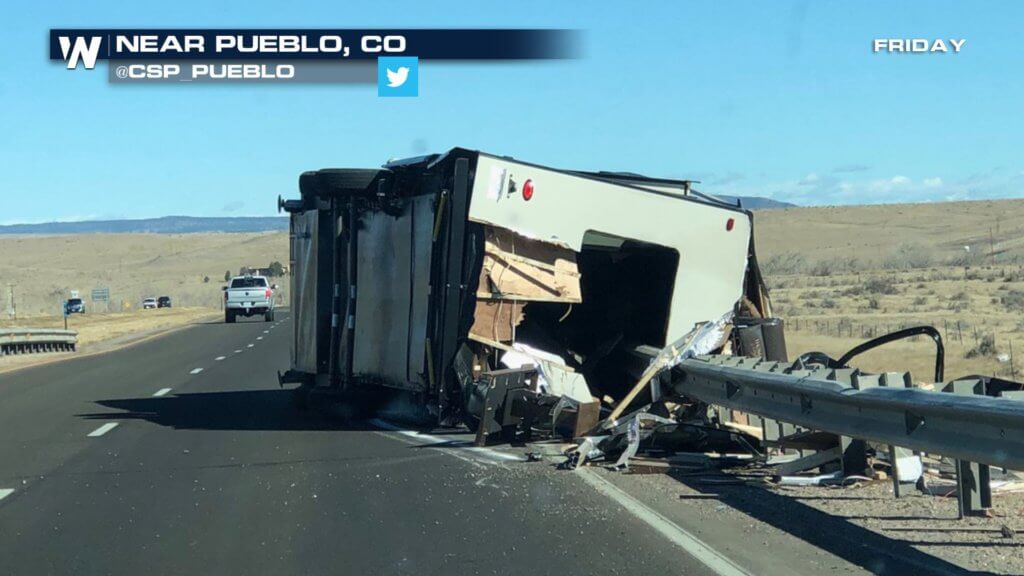
RVing in Heavy Rains
I don’t mind driving in the rain but I don’t like driving in heavy rain. Aside from poor visibility, you have the possibility of standing water, hydroplaning, and all the other drivers facing the same challenges. Sometimes I’ll just pull over until the worst of it passes.
In my mind, there are few things about RVing that are more miserable than setting up or breaking down camp in heavy rain so I try to avoid that. If I happen to arrive at a particularly wet time, I’ll pull in, unplug the truck to trailer electrical cable, and if I have power available I’ll hook up the power cord and wait until the weather is better to do the rest of my setup.
Monsoons
We do have a monsoon season here in the United States. The desert Southwest areas have monsoons during the summer months, typically July through September.
Monsoons can drop a tremendous amount of rain in a short time causing flash flooding. If you camp in the desert during monsoon season, make sure you stay away from desert washes. These are basically dry river beds where water flows, sometimes from storms many miles away. You may not even be aware of the storm until the water reaches you. You may not be camping in bad weather but in the desert, the weather from very far away can ruin your trip.
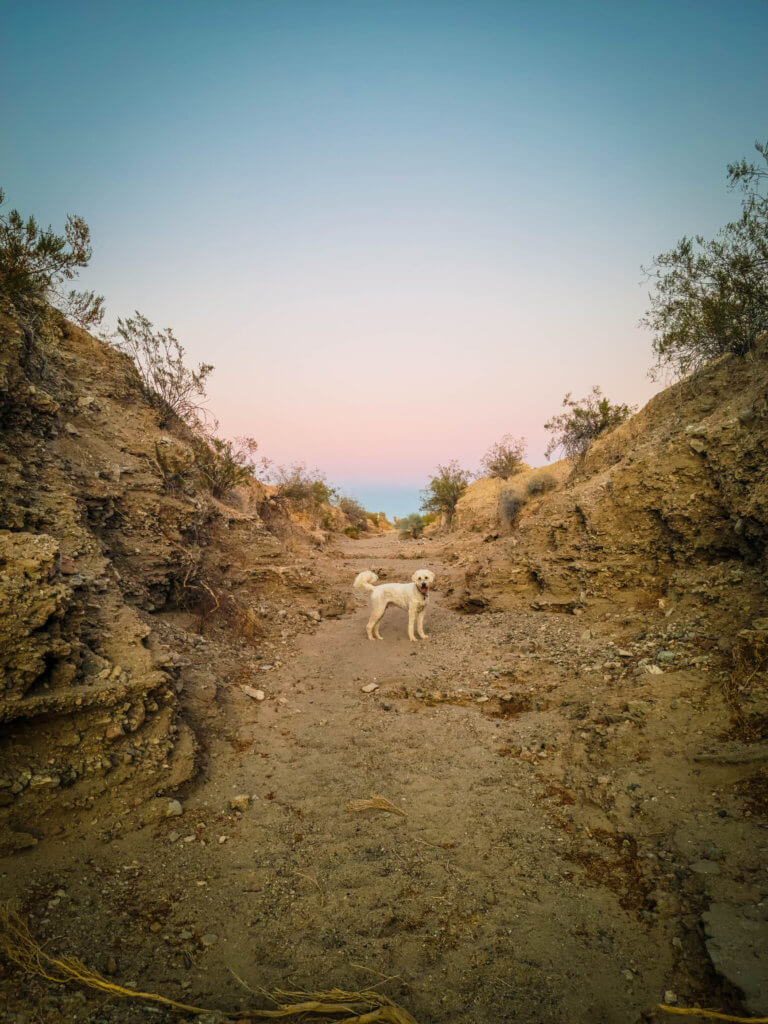
Hail
Hail is often associated with severe storms. Hail storms occur in many parts of the country, but the three states with the most hailstorms are Nebraska, Colorado, and Wyoming. This area is actually called Hail Alley. The majority of these storms occur between May and September. Camping in bad weather in this area can happen very unexpectedly.
Few words strike fear in the hearts of Airstream owners like the word hail. Hail will damage any RV if it’s large enough but even smaller hail can make your Airstream look like a pair of thighs with severe cellulite. Nobody wants that!
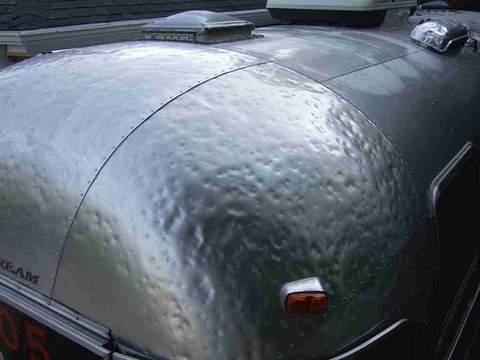
Often an Airstream with hail damage is totaled by the insurance company because it’s just too expensive to fix.
I was driving in Utah one day and got caught in a hail storm. The cars on either side of me both ended up rolling over in the ditches. See; A Tough Driving Day in Utah.
Snow and Ice
If ice and/or snow are on the menu, I take a pass on driving.
That said, I realize these things can happen suddenly and unexpectedly so I carry tire chains for my truck and I know how to install them. I’ve been driving over mountain passes and found snow on the road in shady places and even driven through falling snow for a few miles. I’m not afraid to drive in the snow. I grew up in Montana and that’s where I learned to drive. I just don’t see the point in putting myself and my home at risk.
My best advice is, don’t drive. If you have to drive, then slow down.
Tornadoes
If the forecast calls for the possibility of tornadoes, I’ll delay my arrival or take a different route in order to avoid them.
Over the years, I’ve been in several situations where there were unexpected tornado warnings and watches. This type of camping in bad weather is scary. In areas where this is a common event, there are usually shelters available in RV parks or campgrounds.
Twice, I’ve participated in the communal trip to the shelter aka, ladies’ room made of cement block. Fortunately, there were no close calls but it’s a bit nerve-wracking.
Once, in an RV park in Alabama, the staff came around and warned us, asked us to put our outside gear away, and flipped over our picnic tables so they wouldn’t be blown away.
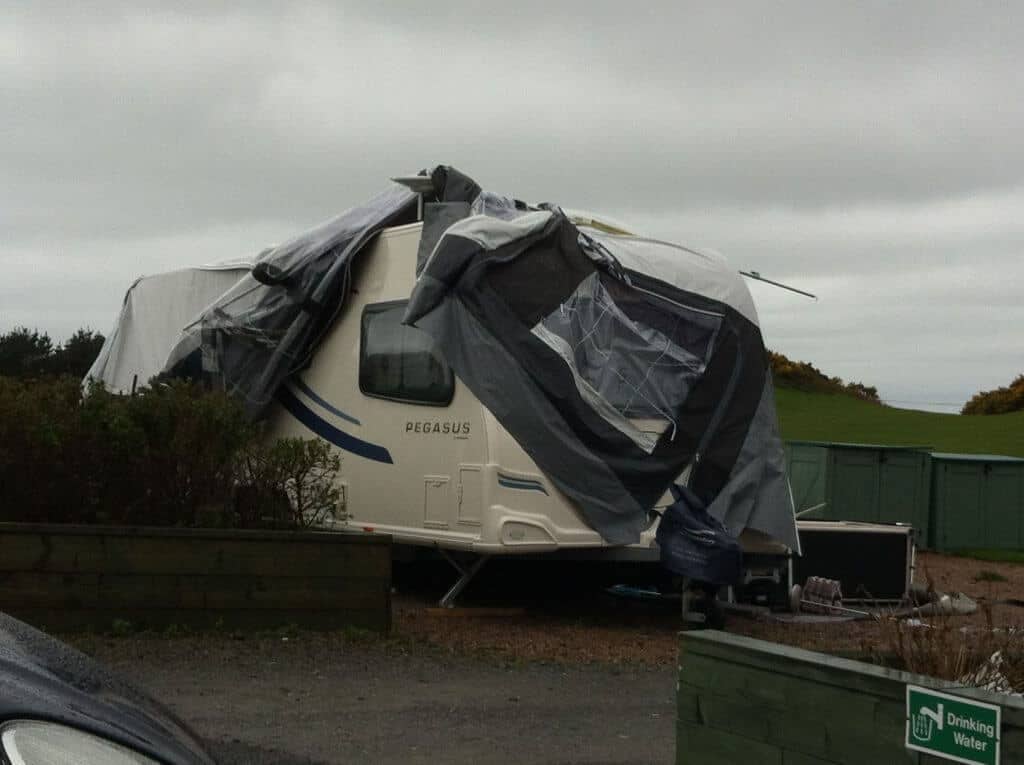
Unfortunately, this was one of the events when people left awnings out and there was a lot of damage. Also, those screened shelters were bouncing all over the park.
Extreme Heat
Traveling on a really hot day can be difficult for many reasons. It’s harder on your vehicle and your body. On warm and hot days, I tow the trailer with the ceiling vent fans on. This helps pull the hottest air out of my trailer.
I also travel with my curtains and shades drawn to keep out the light and heat.
If it’s a particularly hot day when you arrive at your destination, it will be HOT inside your rig and it takes a long time for the interior to cool down. It can also get hot like a little oven inside the cabinets.
When I arrive, I get parked and one of the first things I do is hook up the electrical cord and get the air conditioner running. Once I’ve finished setting up camp, I’ll open up all of my cabinets so cooler air can circulate inside them. This makes the whole unit cool off much faster.
Extreme Cold
One of the beautiful things about RV travel is avoiding camping in bad weather. Sometimes I fail and that and end up really cold or really hot.
If you end up in freezing temperatures, make sure you run your furnace to keep your plumbing from freezing. If your plumbing freezes it can cause a lot of damage and costly repairs.
If you just have some nights below freezing and it warms up during the day, your plumbing should be fine. Once the sun comes out my trailer warms right up.
Haboobs and Dust Storms
Last winter, I ended up in a terrible dust storm in the desert. It was bad enough that I decided to stop for the day. The visibility was very poor and the winds were dangerous.
You can read about that adventure in this post. What’s it Like to Camp in a Dust Storm.
A Dust Storm in New Mexico Abruptly Halts Our Travel
Dust storms are dangerous in many ways. Visibility is an issue, the blowing dust gets into EVERYTHING. I’m still cleaning dust out of the little nooks and crannies in my truck and trailer from that storm in New Mexico.
Particularly severe dust storms in the desert southwest are called haboobs. They get their name from the Arabic word for blasting.
Tips to Help You be Prepared Camping In Bad Weather
- Know the weather can change quickly and without warning.
- It’s also important to be aware of any potential hazards that might arise from the current weather conditions like black ice, or hail.
- Knowing what kind of weather is expected will help you determine what type of clothes and supplies are needed for your trip.
- Pack enough food and water for everyone in case roads are blocked by snow or other obstacles due to inclement weather.
We RVers usually have the ability to stop or stay somewhere longer if the conditions are not good for travel. Build some flexibility into your itinerary to allow for changing or unexpected weather conditions.
If you like this post, please pin it.
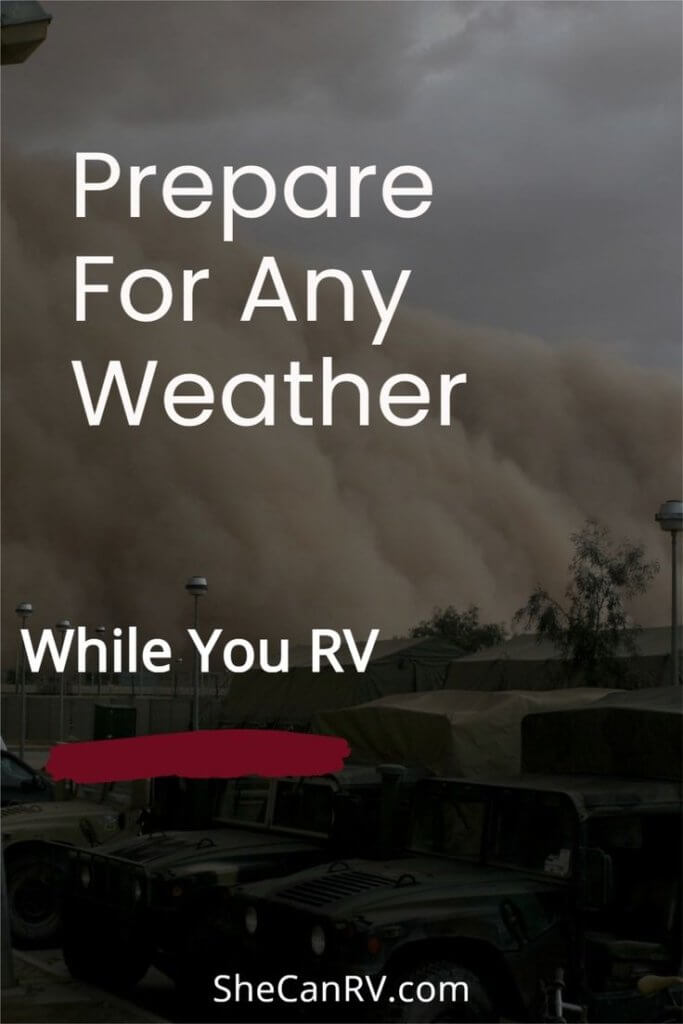
An extremely well written and accurate posting. Thank you.
Thanks Barney! So much of RVing just comes to us with experience. Hopefully someone can benefit from my experience and mistakes.